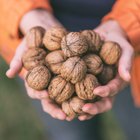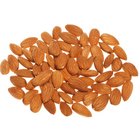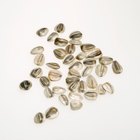
Macadamia nuts originated in Australia and were introduced to Hawaii in the 1800s, where they eventually cultivated the smooth shelled strain of macadamia nuts most commonly sold and bought. Macadamia trees are also grown in California and Florida. The shelled macadamia nut is compared to the chick pea for it's size, color and shape. Macadamia nuts have a sweet, buttery taste and are called for in numerous recipes from cookies to meats. However, many people have found they are best just toasted and eaten by the handful.
Crack open the macadamia nuts. This could take a little while to get the hang of hitting the nut just enough crack the shell and not break the nut inside. You can wrap the nut in a thick towel and then start hitting it with a hammer on a hard surface, set it in the freezer for an hour to weaken the shell or boil it for a couple of minutes to soften the shell. You can also use a C-clamp to break the shell open or buy a macadamia nut cracker.
Examine each nut once it is shelled. Macadamia nuts that are shriveled or moldy should be thrown away as they could be rancid or bitter. You can also taste one or two to make sure that they are fresh and ready to toast.
Set the nuts in a pan. Place the shelled macadamia nuts in a single layer in a shallow baking pan. You can also toast the macadamia nuts in a frying pan over medium heat. Do not grease either the baking pan or frying pan or sprinkle salt over the nuts. Toasting macadamia nuts bring out their sweet buttery taste.
Cook the nuts. The oven will need to be preheated at 325 degrees. Once the oven is ready, set the shallow baking pan with the shelled macadamia nuts inside. Let them cook for 3 to 5 minutes. Halfway through the toasting, either stir the nuts with a spoon or give the baking pan a shake or two. This will keep them from cooking too much on one side. This also goes for toasting the macadamia nuts in a skillet on the stove.
Take them out of the oven. Once you can start smelling the toasted macadamia nuts or they have achieved an even golden brown on all sides, take them out of the oven. If left in the baking pan or skillet they may continue to brown. You can pour the nuts into another pan to cool.
Related Articles
How to Toast Pistachios

What Is a Hickory Nut?

Types of Edible Hickory Nuts

How to Eat Hickory Nuts

How to Prepare Raw Walnuts

How to Make Salt and Spices Stick to ...
How to Toast Almond Slivers

How to Blanch & Peel Hazelnuts

How to Dry Mulberries

How to Cook Raw Almonds
How to Salt and Dry Pistachios

How to Eat a Raw Chestnut

Is There a Difference Between Sunflower ...

How to Store Raw Peanuts

How to Make Sugared Almonds

How to Cook Chestnuts in a Microwave ...

How to Keep Macadamia Nuts Fresh

Cooking Frozen Potato Gnocchi in Butter

How to Make a Baked Stuffing
How to Cook Boneless Skinless Chicken ...
Writer Bio
Maryelser is a full time freelance writer. She specializes in cooking, gardening and crafts and has published numerous articles on eHow.com.
Photo Credits
LuxTonnerre